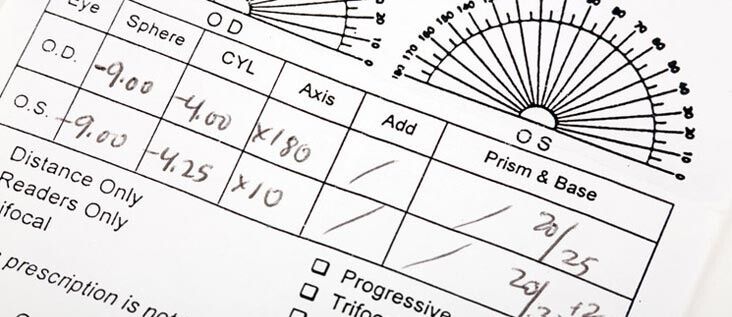An eyeglass prescription contains valuable information regarding your visual needs and vision correction. To those with little or no optical knowledge, how an eyeglass prescription is written may look like a chaotic mess of symbols, letters and numbers. Each component of an eyeglass prescription represents a very important value that tells your eye care practitioner a lot about your eyes, sight, and vision correction needs. When getting eyeglasses, your optician will read your prescription and determine which lens options are best suited to what has been prescribed by your optometrist.
Sphere Component (SPH)
The first number in your eyeglass prescription is called the sphere or spherical value. This number represents whether you need vision correction for being farsighted (hyperopic), written with a plus sign in front, or nearsighted (myopic), written with a minus sign in front. The numbers behind the “+” or “-” symbols represent the focusing power of an eyeglass lens needed to see clearly. These numbers are measured in a unit of measurement called Diopters. Typically eyeglass prescriptions are written in quarter Diopter steps (0.25). A person with a prescription of 0.00, has no correction for distance or near. Generally, the further away from zero the numbers go, the worse a person’s prescription is. For example a person with a -1.25 of nearsightedness, has a much milder prescription then a person with a -8.50.
Cylinder Component (Cyl)
The cylinder and axis component of a prescription, are corrected when a person needs correction for astigmatism. Astigmatism is when light doesn’t focus in one sharp point within the eye, this results in vision blur. For people who need correction for astigmatism, their eyeglass prescription will have additional values behind the sphere number value. The additional numbers make up the cylinder and axis component of the eyeglass prescription. The cylinder value can be written with either a plus or minus sign in front. This is because different eye care practitioners write the prescriptions differently. It is common practice for optometrist to prescribe cylinder in minus value, while ophthalmologist prescribe cylinder in plus. Just like with the sphere component, cylinder is also measured in diopters. The number also get’s higher when a person’s astigmatism is worse.
Axis Component
The number behind the cylinder number represents the Axis value. This number will be a value anywhere between 001 and 180. It is measured in degrees, and determines the alignment or orientation which the astigmatism needs to be corrected at. Astigmatism can not be corrected without an assigned axis value.
Prism
Prism is prescribed, usually when a person has problems with their eyes aligning or working together. This is generally used for people with eye turns and eye muscle imbalances. By adding prism to a prescription a person may feel that their eyes are more at ease. For those who see double vision, when prescribed prism, the image they are seeing as double will become one. Prism works by moving the optical centre of the lens in a certain direction to displace an image. The image is displaced dependent on the direction the prism is prescribed. This displacement is referred to as “base”, and can be either up, down, in, or out. Prism is also written in prism diopter units. It usually has a triangle behind the number value as well as the direction of the prism base. By displacing the lens, the image is brought into alignment with the image the other eye is seeing. This allows the eyes to work in sync together.
Add
A reading addition or “add” is prescribed in addition to the distance correction, to help the eyes focus up close. The number value of the reading add required is always written in a “plus” power, and is usually the same in both eyes. Reading powers usually will range from +0.75 to +3.00. This measurement determines that you need different prescription for looking in the distance and reading. Generally an add, will start to be prescribed for patients in their mid to late forties. It is around this time when people typically become presbyopic. Presbyopia, is the natural aging of the lens within the eye that causes people to lose their focusing ability up close. When an ADD is present in the prescription, multifocal, bifocal, or single vision distance and reading glasses will usually be recommended by the optician to correct all distances of vision.
Article Written By: Trina Vanaalst

